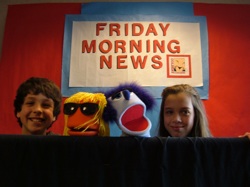Schools Build Community with Student News Programs
Schools are using digital video production in their efforts to foster 21st century skills in their students. Administrators are finding that these programs can also reach out to disconnected students and strengthen school community, with kids as young as 5 years old contributing.

Friday Morning News is anchored by student-controlled puppets.
|
Jared Hoadley sat at a table, playing with a pair of Barbie dolls, and talking in a high falsetto. As he saw the camera move in front of him, he gave a startled look, tossed the dolls over his shoulder, and stuttered a hello as if he were a grown man who had just been caught playing with dolls.
Hoadley is the principal at Colbert Elementary School in Spokane, WA, and the video was a part of Jack Scott's presentation at the Northwest Council for Computer Education's 2011 conference in Portland, OR.
Scott, a school social worker, runs Colbert's Friday Morning News program with plenty of help from Tech Club Teacher and Adviser Colten Cain, a senior at nearby Mt. Spokane High School.
Librarian Jill Perry started the 15-minute-long news show that is broadcast throughout the school on the first Friday of every month. It's anchored by puppets and includes features such as video clips of recent school activities or the student council sharing information about school programs. Other highlights of the show include:
- Segments illustrating the character word of the month, such as trustworthiness or respect;
- Acknowledgement of parents, students, and staff;
- Fundraising events;
- Holidays; and
- Anti-teasing and bullying strategies.
But according to Colbert's teachers and administrators, Friday Morning News does much more than just communicate information. Linda Cameron-Jokinen's third grade students put together a skit about the boy who cried wolf to illustrate the character word honesty. She said that the skit met state targets for reading, memorization, and public performance. "More importantly," she said "my students felt connected to the leadership in our school by performing for the Friday Morning News."
Hoadley, who said the program started eight years ago to replace assemblies that weren't working out because of fire codes, agreed. The kids "know me," Hoadley said, "but they know me though TV, which is a medium they understand."
Anh Nguyen-Johnson, a technology teacher at Forest Park Elementary School in Portland, Oregon, runs a similar program with six fifth grade students known as the Junior Reporters Squad. Nguyen-Johnson attended Scott's presentation looking for ideas she might incorporate into her own program and liked the fact that Hoadley was "so energetic and entertaining" in the piece that he does for the Friday Morning News every month, and hopes to incorporate administrators from her school in the future.
She also said that she "liked that the tasks were broken up into different groups of kids, like the writers association, the puppet team, and the Tech Club," thinking that it might be a way to incorporate more students.
Nguyen-Johnson's Junior Reporters visit Portland's KPTV news department and don't use puppets, modeling their show more on a traditional news program. That doesn't mean they don't have fun, though. Nguyen-Johnson said that when the University of Oregon football team played in the Bowl Championship Series title game this January, "That was a huge thing for our school because we had so many Duck fans, and there was so much Oregon pride going on there." So she let one of her students take a flip camera to the game in Arizona with him to shoot a story about it.
At both schools the programs are written, performed, and taped by the students, and Scott said he thinks it's important to find the kids who can benefit the most from participating, rather than those who are already skilled performers, writers, and videographers.
"Let me tell you a little story about Daniel (not his real name)," Scott told the crowd at NCCE, "When I came to Colbert, Daniel would go out to recess and he'd just sit on this bench out there. And other kids were trying to get him to play, and he wouldn't play. Pretty soon some kids teased him a little bit. Daniel would not get involved. He was disenfranchised, he was just a loner, he was isolated. So when I got involved with this, I thought, who's going to be my first tech person? Daniel."
Daniel agreed, and Cain taught him how to use the cameras. Soon, Daniel was recording things for teachers. "Daniel started talking to teachers, teachers started talking to him."
The costs of the program at each school are low. Scott and Nguyen-Johnson both edit the shows on Macs running iMovie, though Scott said he hopes to have the students take on more of the editing in the future, and students use low-cost camcorders to capture the footage. The students at Colbert make a commitment when they join the program to miss some of their time at lunch and recess to work on the show, while the Junior Reporters agree to make up for the class time they miss.
Colbert doesn't post the Friday Morning News online owing to concerns about student privacy, but the Junior Reporter Squad can be seen in action on their page at the Forest Park website.
About the Author
Joshua Bolkan is contributing editor for Campus Technology, THE Journal and STEAM Universe. He can be reached at [email protected].